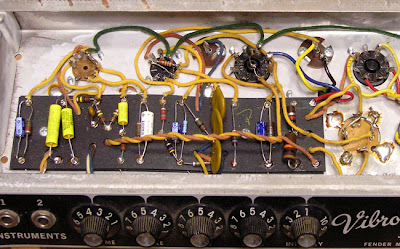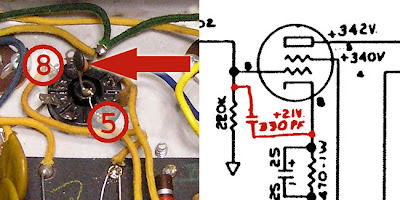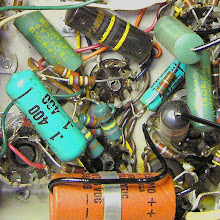Here's a picture of the inside of a Fender AB764 Vibrochamp that was in for repairs:

An new JJ 6V6 got it running again but even with it's Weber alnico speaker it didn't sound all that good. I replaced the tone stack and coupling caps and that helped. But the interesting part of this repair was a more elusive capacitor problem.
Many later Fender amps have capacitors in the output section that were put in to suppress parasitic oscillations. I like to remove these if possible to brighten the amp up a bit.
In this particular one there were actually two ceramic caps (one dark brown and one tan) connected in parallel from pin 5 to pin 8 on the 6V6 power tube. The arrow indicates them in the picture and I've highlighted the cap in red on the schematic to the right.

The trick about removing these caps is that they were originally installed to fix a problem. So sometimes when you remove them the problem rears it's head again.
That was the case in this one. When I removed the parasitic oscillation cap the amp got a bit dirtier and actually sounded darker not brighter.
You'll notice the picture of the Vibrochamp circuit that there are two wires twisted together sort of like these two I've twisted together here:

One of these two wires carries the B+ voltage to the preamp stages from the power supply and the other connects the output of preamp to the input of the 6V6 power tube.
They're going in the same general direction. So why not twist them together? Nice and neat, isn't it?
Well let's hook the two wires I've twisted together up to the capacitance meter. Here are the leads of the meter connected to two ends of the wire:

And here's what the capacitance meter reads with the probes connected to the ends of the wires:

That's almost 30pF that would be connecting the preamp B+ to the 6V6 input at high frequencies! Doesn't sound like a great idea does it?
The fact is that capacitors exist in all sorts of places where we don't intend them to be. And this can cause problems, especially at high frequencies. Capacitance is, after all, just an electrical characteristic of physical materials. The components we call capacitors are just things that are carefully manufactured to optimize and control the capacitance of those physical materials. There are plenty of capacitors that we buy and install into our amps. But there are plenty of others that happen through accidents of layout and lead dress.
Suspecting unwanted capacitance in the twisted pair of wires in this Vibrochamp I unhooked them, straightend them and hooked them up again.

Above you can see them reconnected. The amp sounded more open, a bit less gritty. And as I'd hoped I was also able to remove the parasitic suppressor cap to brighten it up a touch.










